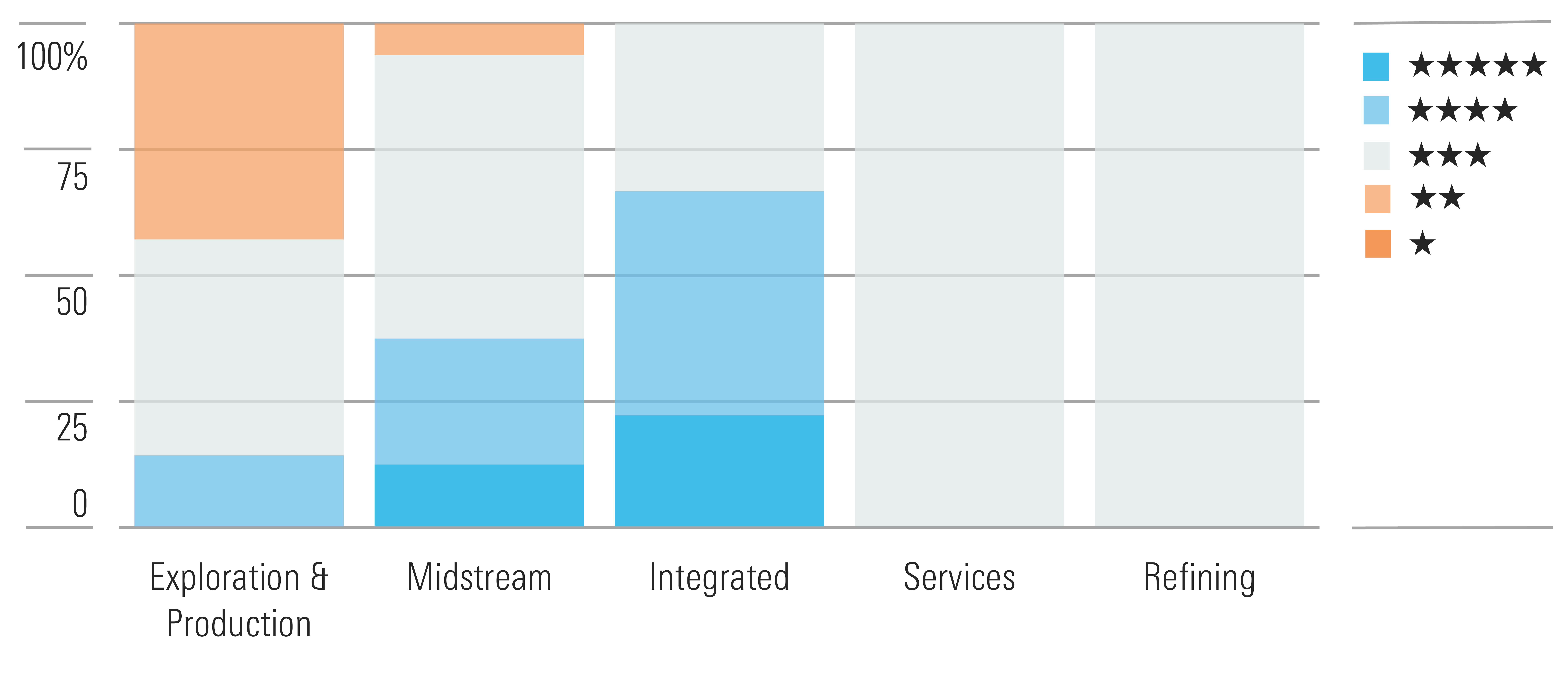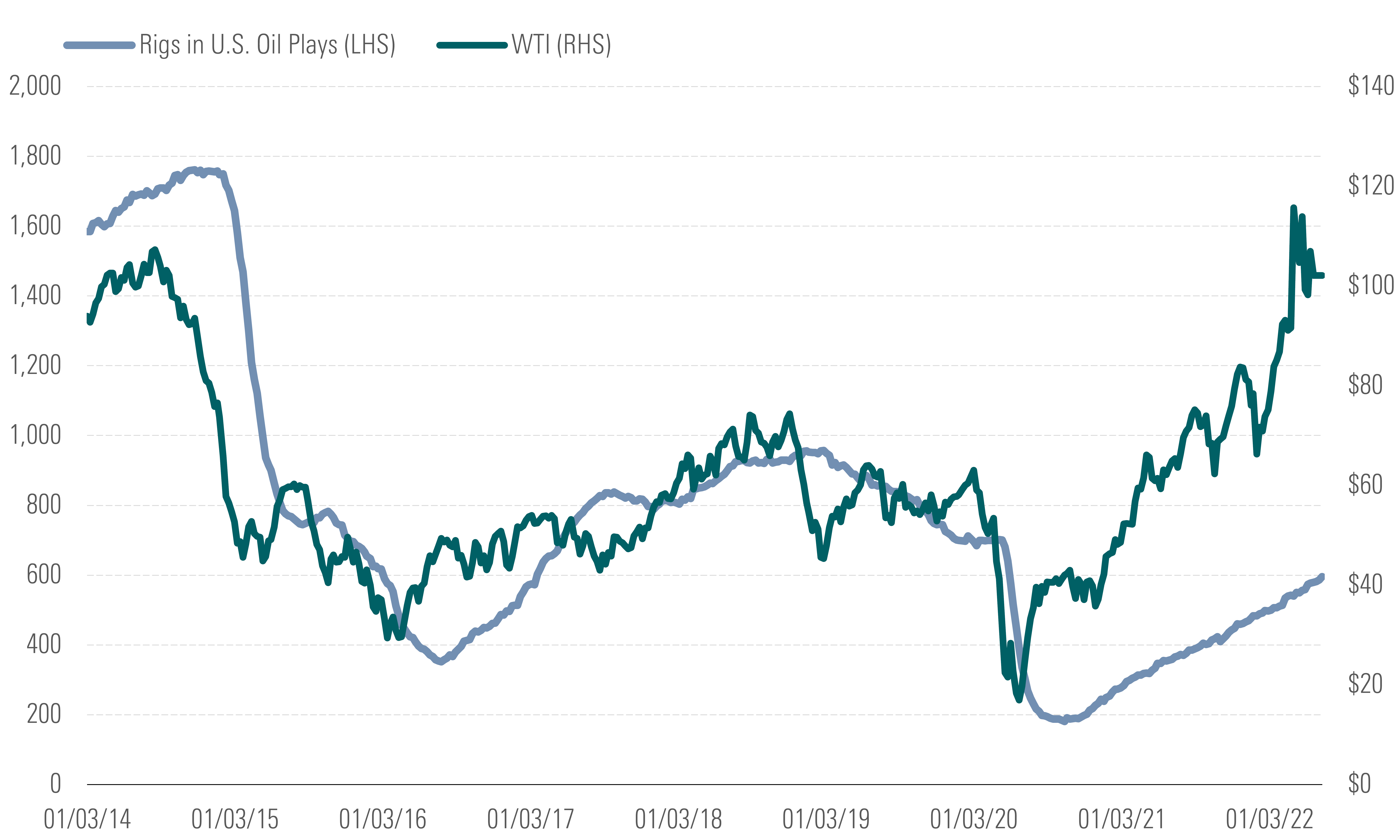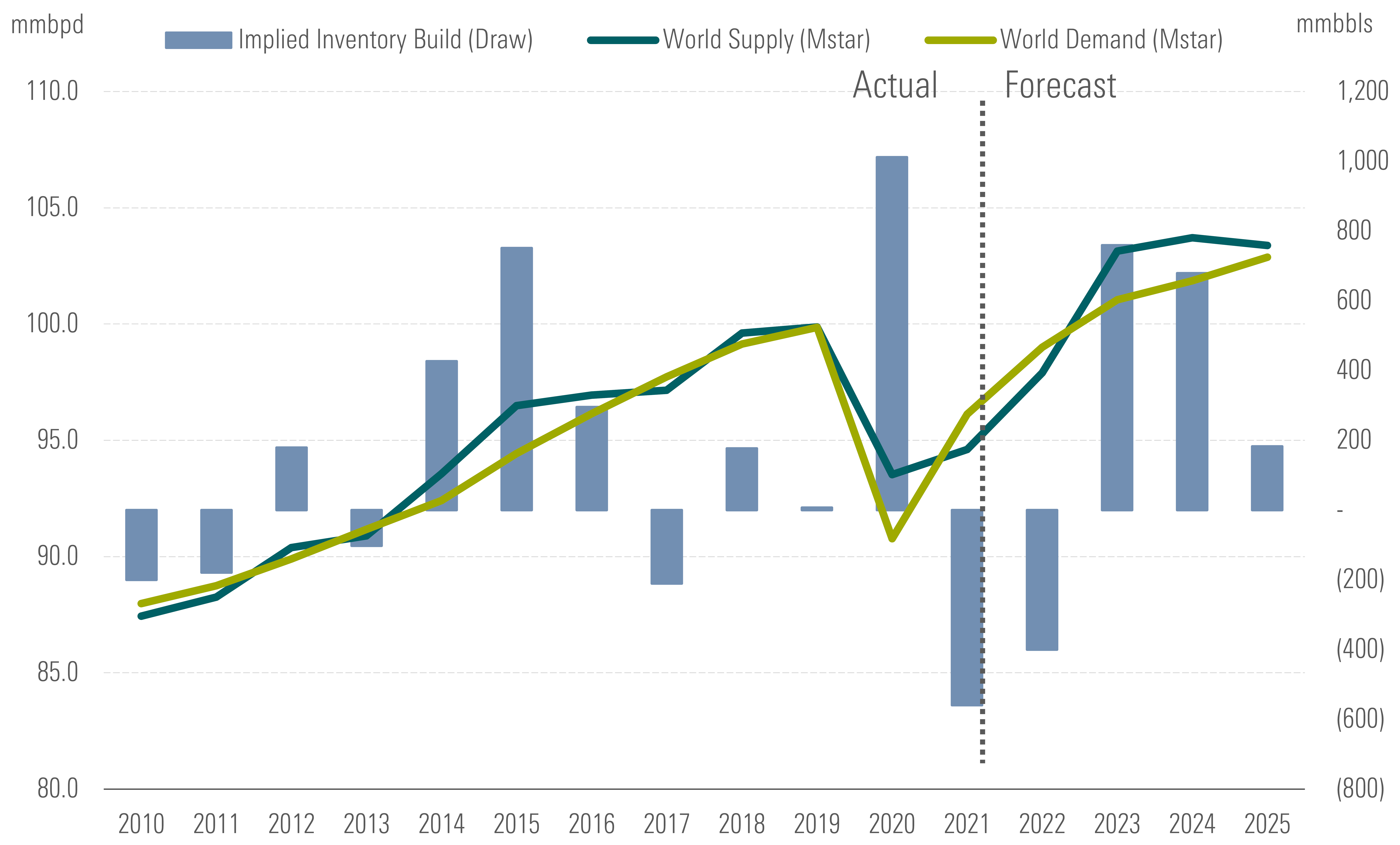Most Energy Segments Fully Priced, but Oil Services Has Some Bargains
Russia-Ukraine war likely to keep oil and gas prices high.
The Morningstar US Energy Index gave back some of its gains from earlier in the year and pulled back 3% in the second quarter compared with the market’s 14.2% decline. Given the sector’s recent surge, we now view the sector as fairly valued, with the median stock trading at a 1% discount. Although most segments are fully priced, we do see opportunities in the oil-services segment, which trades at an average discount of 28%.
Russia-Ukraine Conflict Continues to Send Energy Higher

- Source: Baker Hughes, Rystad, Morningstar. Data as of June 27, 2022.
The crisis in Ukraine was the main catalyst for soaring oil and natural gas prices in the second quarter, which also buoyed energy stocks. The market was already stretched before the invasion of Ukraine, given the relatively rapid postpandemic rebound in consumption (which contrasted with a more lethargic supply response, particularly from traditional swing producers such as OPEC and the U.S. shale industry).
But Some Opportunities Remain, Especially in Oil Services

- Source: Baker Hughes, Rystad, Morningstar. Data as of June 27, 2022.
These shortages were exacerbated by escalating Western sanctions on Russia, which last year accounted for about 10% of world supply. On May 31, the European Union announced the strongest measure yet, banning Russian oil imports altogether. Without precise data, the magnitude of the disruption is uncertain, but estimates range from 1 million-4 million barrels per day. We expect Russian oil supply to fall to 9.7 mmb/d in 2022 and 9.3 mmb/d in 2023 (from 10.8 mmb/d in 2021).
U.S. Drilling Has Decoupled From Commodity Prices

- Source: Baker Hughes, Rystad, Morningstar. Data as of June 27, 2022.
Those are severe deficits, and there isn’t much latent supply elsewhere to offset them. OPEC is steadily ramping and recently pledged to raise its planned increases by 50% in July and August, but that adds only about 400,000 barrels a day. U.S. producers are growing, too, albeit at a measured pace. Producers claim disciplined capital allocation and the prioritization of shareholder returns are holding them back. But inflation and supply chain bottlenecks are likely to blame, as well.
There was hope that the Ukraine crisis and the resulting commodity price spike would foster improving U.S.-Iranian relations and perhaps pave the way for re-entering the nuclear agreement (the current sanctions are suppressing at least 1 mmb/d of Iranian exports). But talks have apparently broken down. In the long run, we still expect crude and natural gas to relax to midcycle levels ($55 per barrel for West Texas Intermediate and $3.30 per thousand cubic feet for U.S. natural gas). But prices will remain elevated in the back half of 2022 unless the Ukraine crisis quickly subsides.
We Expect Dwindling Inventories to Be Replenished in 2023-24

- Source: Baker Hughes, Rystad, Morningstar. Data as of June 27, 2022.
Top Picks
Schlumberger SLB Star Rating: ★★★★ Economic Moat Rating: Narrow Fair Value Estimate: $49 Fair Value Uncertainty: High
Although rallying share prices have removed much of our oilfield-services coverage from deeply undervalued territory, investors can still get industry leader Schlumberger for a bargain. We expect industry activity to recover from COVID-19, with long-run activity in international markets (where Schlumberger focuses) even surpassing prepandemic levels. We think Schlumberger will continue its historical record of leading peers in technological progress and generating high returns on capital.
ExxonMobil XOM Star Rating: ★★★ Economic Moat Rating: Narrow Fair Value Estimate: $96 Fair Value Uncertainty: High
Exxon management responded to shareholder concerns and activist pressure by pulling the reins on its once-aggressive investment plan. However, it still plans to double earnings from 2019 levels by 2025 and double cash flow by 2027 on a combination of structural operating cost reductions, portfolio improvement, and growth across its upstream, downstream, and chemical segments. Exxon estimates that under the current plan, it will generate about $100 billion in surplus cash, after funding investment and paying the dividend, during the next five years. As such, we expect its current repurchase program of $10 billion over the next 12–24 months to be just the beginning. This combination of potential earnings growth and cash return is unrivaled elsewhere in the sector.
Coterra Energy CTRA Star Rating: ★★★★ Economic Moat Rating: Narrow Fair Value Estimate: $32 Fair Value Uncertainty: High
Coterra is highly leveraged to both crude and natural gas prices, thanks to the merger of Cimarex (which focused on the Permian and Oklahoma) and Cabot (a Marcellus Shale pure play, producing exclusively gas). As such, it is one of the few U.S. producers with true commodity and geographic diversification and can roll with the punches by shifting capital wherever the returns are highest. The firm is currently benefiting from skyrocketing prices, though it is keeping production flat rather than growing to prioritize its generous capital returns program (consisting of a base dividend currently yielding 2%, a variable dividend that ensures at least 50% of free cash is distributed quarterly, and a $1.25 billion buyback program).

/s3.amazonaws.com/arc-authors/morningstar/17f48ad3-acb4-4abc-982b-fb3b14ceda2f.jpg)
/cloudfront-us-east-1.images.arcpublishing.com/morningstar/347BSP2KJNBCLKVD7DGXSFLDLU.jpg)
/cloudfront-us-east-1.images.arcpublishing.com/morningstar/TP6GAISC4JE65KVOI3YEE34HGU.jpg)
/d10o6nnig0wrdw.cloudfront.net/04-29-2024/t_d0e8253d77de4af9ae68caf7e502e1bf_name_file_960x540_1600_v4_.jpg)
:quality(80)/s3.amazonaws.com/arc-authors/morningstar/17f48ad3-acb4-4abc-982b-fb3b14ceda2f.jpg)